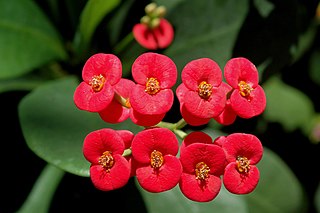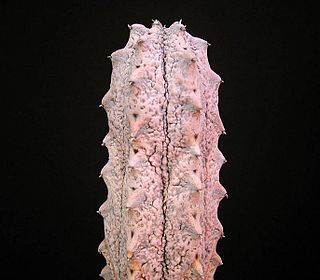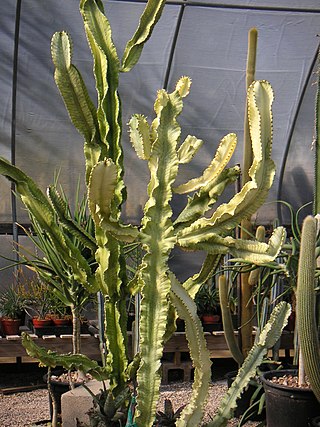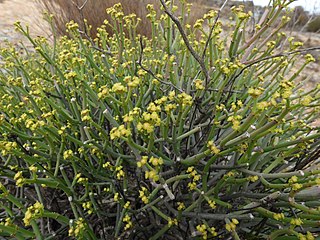
Euphorbia is a very large and diverse genus of flowering plants, commonly called spurge, in the family Euphorbiaceae. "Euphorbia" is sometimes used in ordinary English to collectively refer to all members of Euphorbiaceae, not just to members of the genus.

The poinsettia is a commercially important flowering plant species of the diverse spurge family Euphorbiaceae. Indigenous to Mexico and Central America, the poinsettia was first described by Europeans in 1834. It is particularly well known for its red and green foliage and is widely used in Christmas floral displays. It derives its common English name from Joel Roberts Poinsett, the first United States minister to Mexico, who is credited with introducing the plant to the US in the 1820s. Poinsettias are shrubs or small trees, with heights of 0.6 to 4 m. Though often stated to be highly toxic, the poinsettia is not dangerous to pets or children. Exposure to the plant, even consumption, most often results in no effect, though it can cause nausea, vomiting, or diarrhea.

Chamaesyce is a genus of plants in the family Euphorbiaceae. Recent phylogenetic studies have shown that Chamaesyce is deeply nested within the broader Euphorbia. Specifically, Chamaesyce is very closely related to plants like Euphorbia pulcherrima, the popular poinsettia. Currently, all species have now been reclassified as species of Euphorbia. Specifically, this group now belongs to Euphorbia subgenus Chamaesyce section Anisophyllum. Taxonomically speaking, Chamaesyce is considered a synonym of Euphorbia.

Euphorbia milii, the crown of thorns, Christ plant, or Christ's thorn, is a species of flowering plant in the spurge family Euphorbiaceae, native to Madagascar. The species name commemorates Baron Milius, once Governor of Réunion, who introduced the species to France in 1821.
Susan Carter Holmes is a botanist and taxonomist. She discovered and catalogued more than 200 plants of the family Euphorbiaceae. Her plants and articles are published under her maiden-name Susan Carter.

Euphorbia abdelkuri is a species of plant in the family Euphorbiaceae. It is endemic to Abd al Kuri, an island south of Yemen. Its natural habitat is rocky areas. The Latex of the plant is toxic.
Euphorbia alcicornis is a species of plant in the family Euphorbiaceae. It is endemic to Madagascar. Its natural habitat is rocky areas. It is threatened by habitat loss.

Euphorbia alfredii is a species of plant in the family Euphorbiaceae. It is endemic to Madagascar. Its natural habitats are subtropical or tropical dry forests, subtropical or tropical dry shrubland, and rocky areas. It is threatened by habitat loss.

Euphorbia ambovombensis is a species of plant in the family Euphorbiaceae. It is endemic to Madagascar. It is native to the area around Ambovombe at the southern end o the island, where it is locally common. Its natural habitats are subtropical or tropical dry forests and subtropical or tropical dry shrubland. It is threatened by habitat loss.

Euphorbia ammak is a species of plant in the family Euphorbiaceae. It is found in Saudi Arabia and Yemen.

Euphorbia ankarensis is a species of plant in the family Euphorbiaceae. It is endemic to Madagascar. Its natural habitat is rocky areas. It is threatened by habitat loss.
Euphorbia smithii is a species of plant in the family Euphorbiaceae. It is found in Oman and Yemen. It is threatened by habitat loss.

Euphorbia canariensis, commonly known as the Canary Island spurge, Hercules club or in Spanish cardón, is a succulent member of the genus Euphorbia and family Euphorbiaceae endemic to the Canary Islands. It is the plant symbol of the island of Gran Canaria.

Euphorbiaceae, the spurge family, is a large family of flowering plants. In English, they are also commonly called euphorbias, which is also the name of the type genus of the family. Most spurges, such as Euphorbia paralias, are herbs, but some, especially in the tropics, are shrubs or trees, such as Hevea brasiliensis. Some, such as Euphorbia canariensis, are succulent and resemble cacti because of convergent evolution. This family has a cosmopolitan global distribution. The greatest diversity of species is in the tropics; however, the Euphorbiaceae also have many species in nontropical areas of all continents except Antarctica.

Euphorbia balsamifera is a flowering plant in the spurge family Euphorbiaceae. It is distributed in the Canary Islands and the western Sahara. It is the vegetable symbol of the island of Lanzarote. Euphorbia adenensis has been treated as a subspecies of this species.

Euphorbia antiquorum, known as antique spurge and "Euphorbia of the Ancients", is a species of succulent plant in the family Euphorbiaceae. It is widespread throughout peninsular India, but its wild origin is obscure. Escaped or naturalized and widely cultivated in neighbouring regions, such as Burma, China, Bangladesh, India, Indonesia, Iran, Malaysia, Myanmar, Pakistan, Thailand, the Philippines, Sri Lanka, and Vietnam, and in many tropical zones worldwide.

Euphorbia anachoreta is a species of flowering plant in the family Euphorbiaceae, endemic to the Fora Islet of the Savage Islands. This species has been considered a Critically Endangered species due to its highly restricted population size. As most other succulent members of the genus Euphorbia, its trade is regulated under Appendix II of CITES.

Euphorbia rhombifolia is a species of flowering plant in the Euphorbiaceae family. It is native to Namibia and South Africa, where it is widespread in clay-rich soils, extending as far east as Kwazulu-Natal.

Euphorbia pulvinata, commonly known as the pincushion euphorbia, is a species of plant in the family Euphorbiaceae native to southern Africa.
Euphorbia momccoyae is a species of flowering plant in the family Euphorbiaceae. It is a succulent shrub found in the Dhofar Governorate, Oman, and the Hadhramaut Governorate, Yemen.















